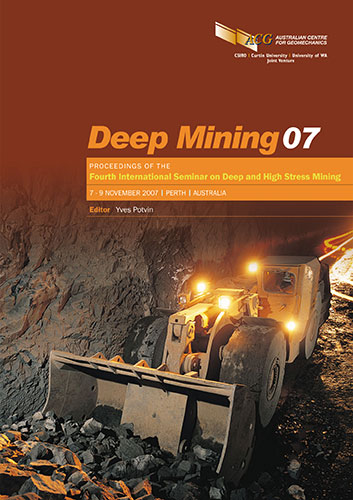The Granites Callie Mine - Justification and Design of a Mine Cooling Plant Suitable for Wet or Dry Condensing

|
Authors: Howes, MJ; Clarke, B Paper is not available for download Contact Us |
DOI https://doi.org/10.36487/ACG_repo/711_33
Cite As:
Howes, MJ & Clarke, B 2007, 'The Granites Callie Mine - Justification and Design of a Mine Cooling Plant Suitable for Wet or Dry Condensing', in Y Potvin (ed.), Deep Mining 2007: Proceedings of the Fourth International Seminar on Deep and High Stress Mining, Australian Centre for Geomechanics, Perth, pp. 451-461, https://doi.org/10.36487/ACG_repo/711_33
Abstract:
The justification for the amount of cooling currently installed and for future expansions at Callie mine at the Granites is based on the application of a heat stress management strategy where a requirement to relocate personnel or impose a work-rest regimen is limited to less than 10% of the summer period. A limiting wet bulb temperature of 30.5°C generally means that the stop work condition of 32.5°C wet bulb does not occur and interruptions to productive mining and development are reduced to acceptable values. Callie mine in the Tanami desert has a water supply that is mainly bore water pumped from a palaeochannel 22 km from the mine and consequently subject to environmental pressures to minimise the amount used. Over a typical summer, wet condensing heat rejection for the cooling plant using conventional methods has a water consumption of between 9.0 Ml/MWR and 12.0 Ml/MWR from both evaporation and the bleed off necessary to maintain the quality of water. Condensation of moisture in the bulk air cooler provides approximately 1.8 Ml/MWR which helps to offset the water losses. The capacity and integrity of the bore field water supply line is not sufficient to guarantee sufficient supply of water to the refrigeration plant and captured rain water from adjacent pits is required as backup to meet the wet condensing requirements. While the pit water is normally available, supply could be compromised due to previous pit wall instability and potential loss of access to the pit pumps. Lack of rainfall could also result in insufficient stored water to supply the plant. These issues encouraged a hybrid condenser design where both wet and dry condensing was possible to allow the plant to continue to run if water was not available. Dry condensing can eliminate water losses however, because the condensing temperature then depends on dry bulb rather than wet bulb, the condensing temperature and therefore the compressor power is higher. For a typical summer, the increased power is 0.25 million kWh/MWR which is a significant with generated power costing up to A$ 0.28/kWh depending on the cost of diesel fuel. Normally, wet condensing would be used with dry condensing as a back up in the event that there was insufficient stored water. With compressor motors that are 25% larger than normal, the plant should be able to provide 87.5% of the summer mine cooling load when operating dry.
References:
Hemp, R. (1987) Air temperature increases in airways. Mine Ventilation Society of South Africa, Volume 40, pp. 1-11.
Howes, M.J. and Sedlacek, J. (2001) Kidd Creek mine – Ventilation and cooling planning for an extension to 3100 m.
Proceedings 7th International Mine Ventilation Congress, Cracow, Poland (EMAG, Poland: Research and
Development Centre, 2001), pp. 991-1001.
Howes, M.J. and Nixon, C.A. (1997) Development of procedures for safe working in hot conditions. Proceedings 6th
International Mine Ventilation Congress, Pittsburgh, USA (Littleton, CO, USA: Society of Mining Engineers,
1997), pp. 191-197.
Howes, M.J. (1996) Elements of a safe heat stress control strategy for mines. Proceedings Health and Safety in Mining
and Metallurgy Conference (London: Institute of Mining and Metallurgy, 1996), pp. 81-94.
Howes, M.J. (1988) Heat and moisture exchange in mine airways. Proceedings 4th International Mine Ventilation
Congress, Brisbane, Australia (Melbourne: Australasian Institute of Mining and Metallurgy, 1988), pp. 257-264.
Nixon, C.A., Gillies, A.D.S. and Howes, M.J. (1992) Analysis of heat sources in a large mechanised development end
at Mount Isa Mine. Proceedings 5th International Mine Ventilation Congress, Johannesburg, South Africa.
(Johannesburg: Mine Ventilation Society of S. Afr., 1992), pp. 109-117.
Moreby, R.G. (1987) Thermodynamic network simulation incorporating airway heat and moisture transfer. Proceedings
4th International Mine Ventilation Congress, Brisbane, Australia (Melbourne: Australasian Institute of Mining
and Metallurgy, 1988), pp. 265-272.
Stoeckler, W.F. (1998) Industrial Refrigeration Handbook, McGraw-Hill, Chapter 7.
Various Topics
Deep Mining 07, Perth, Australia 461
© Copyright 2025, Australian Centre for Geomechanics (ACG), The University of Western Australia. All rights reserved.
View copyright/legal information
Please direct any queries or error reports to repository-acg@uwa.edu.au
View copyright/legal information
Please direct any queries or error reports to repository-acg@uwa.edu.au